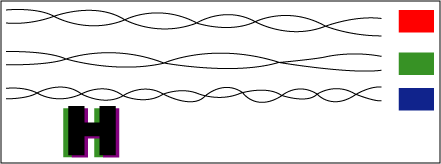Skewing effect
Higher or lower twist ratios
Within a CATx cable of a certain length, the individual pairs might have individual different lengths, caused by higher or lower twist ratios.
There are two common cable standards:
- One with a 2 + 2 structure (two pairs of approximately length A and two pairs of approximately length B).
- one with a 3 + 1 structure (3 pairs of approximately length A and one other pair of a different length B).
Different runtimes
Sending a signal across cable pairs that are different in length causes different runtimes.
This runtime-caused signal delay is called skew. Of course, the longer the cable, the higher the skew can be. This affects the video signal—the picture on the remote screen.
The colour signal arriving earlier (over shorter, less twisted pair) is moved more to the left side of the screen, the colour signal arriving later (over a longer pair with higher twist ratio) is moved to the right.
All colours displayed on a screen are made of red, green and blue. If skew occurs, even a simple black character might appear blurred.
You have three options
To avoid this impact on picture quality, there are three options:
The cheapest is to select an appropriate cable or change pairs within the cable to minimise runtime delays. As this is often not allowed or possible, you can use external Delay Lines to adjust differences (call Tech Support about the ACUDLY or ACU5100A).
When starting from scratch, the most suitable solution is the new ServSwitch CATx KVM Extender with Built-in De-Skew and Multi Video Support (ACU2xxx series) It provides an individual built-in colour DeSkew of up to 42 ns (42 x 10-9 sec) in steps of 2.8 ns (approximately half a pixel size at 1600 x 1200 resolution) via simple keyboard commands.
Preset modes help in finding the right settings! All settings are saved in nonvolatile flash memory.

As described already, three pairs carry colour and synchronisation signals (one colour pair). Cables rated higher than CAT5 don’t have equal pair lengths to fulfill their intended Ethernet specifications, so the colour signals arrive at a different time at the remote end.